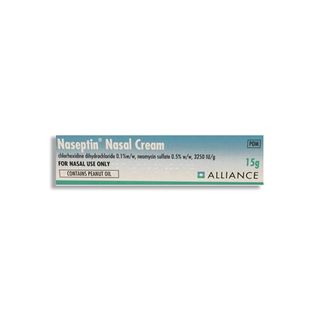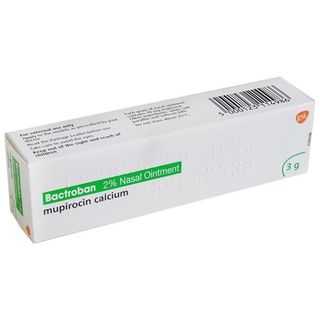
Nasal Infections
Having a nasal infection isn’t a lot of fun. Pain and inflammation in the nostrils and surrounding skin can leave you feeling feverish, tired and very bunged up. Some people may also experience bad breath, a loss of smell or a cough that gets worse at night. Occasionally, a nasal infection can spread to the skin around the mouth, causing painful crusting and scabbing. But don’t worry, this common issue can be easily treated, with an antibiotic ointment generally all that’s needed to send the infection on its way. We're here to provide you with the treatments and support you need to manage nasal infections effectively and help you get back to your best.
Nasal Infections Treatments
- Out Of Stock
 Naseptin Nasal Cream
Naseptin Nasal Cream - Out Of Stock

Bactroban 2% Nasal Ointment
Bactroban 2% Nasal Ointment
View recommended products for Nasal Infections
Don't wait to get the medical help you need.
View our recommended treatments and select your preferred treatment and quantity from a list of options for you.
Selected by our UK-based medical team
Quick and easy checkout
Treatments dispatched same day (before 3pm)
Ordering as easy as 1, 2, 3
1. Find the ideal treatment
We can provide over 1099 leading medicines to treat over 94 conditions.
2. Get a free consultation
Our qualified healthcare professionals will assess your condition and needs.
3. Enjoy speedy delivery
And when the time comes to re-order, it'll only take a couple of clicks.
Advice for Nasal Infections
What is a nasal infection?
Nasal infections are usually caused by bacteria entering injured tissue on the nose, or the skin surrounding the nostrils. When suffering from a nasal infection, your nose is likely to feel sore, or painful to the touch. You may also develop pimples, crusting, and scabbing inside your nostrils.
Typically, these infections result from Staphylococcus bacteria entering broken tissue and are easily treated through the use of topical antibiotics.
What’s the difference between a nasal infection and a sinus infection?
While the two are commonly confused, nasal infections are not the same as sinus infections.
Sinus infections (such as acute sinusitis) are caused by an infection of the sinuses — the small air-filled cavities behind your cheekbones and forehead. Sinus infection symptoms include nasal congestion, excess mucus production (a runny nose), and flu-like symptoms.
A nasal infection, on the other hand, is the result of an infection of the skin in or around the nose. Occasionally, the infection may also spread to the mouth.
Nasal infection symptoms
The term ‘nasal infection’ is actually used to describe a group of different conditions, each one with its own set of symptoms.
Two of the most common nasal infections are nasal vestibulitis and impetigo — both of which stem from a bacterial infection of the skin.
Generally, a nasal infection will cause the following symptoms:
- Inflammation of the nose and nostrils
- Pimples on or inside the nose
- An achy, sore nose that is painful to touch
- A crusty, scabby layer of skin that forms in and around the nose
A nose infection will rarely cause a blocked, runny, stuffy nose, as these are more common sinusitis symptoms associated with an acute sinus infection.
Types of nasal infection
Nasal vestibulitis
Nasal vestibulitis is an infection of the skin surrounding the nostrils (known as the vestibule of the nose). It can be caused by a number of things, such as an infection (usually by Staphylococcal bacteria), allergies, or exposure to irritants.
Typically, the infection will arise from a small injury in the nasal vestibule. These injuries may be caused by nasal hair plucking, picking your nose, excessive nose blowing, or having your
nose pierced.
Nasal vestibulitis symptoms include:
- Inflammation and puffiness both inside and outside the nostril
- A small, raised bump resembling a pimple inside the nostril
- Tiny bumps around the hair follicles inside the nostril (folliculitis)
- Scabbing or crusting in or around the nostril
- Aching and sensitivity in the nose
- Abscesses or boils inside the nose (nasal furuncles)
Impetigo
Impetigo is a bacterial skin infection that typically affects the face, particularly around the mouth and nose.
It is characterised by the formation of small, fluid-filled blisters that eventually burst, leaving behind red, crusted sores. These sores are highly contagious and can spread to other areas of the body if not properly treated.
Impetigo is most common in children, but can also occur in adults. Like nasal vestibulitis, an impetigo nose skin infection is caused by the bacteria Staphylococcus aureus or Streptococcus pyogenes and can be treated with antibiotics.
Impetigo symptoms include:
- Blisters filled with fluid, which can break open and crust over
- Red, swollen, and itchy skin
- Sores on the face, particularly around the nose and mouth
- Yellow or honey-coloured crusts on the skin
- Mild fever and swollen lymph nodes in some cases
Causes of nasal infection
The most common cause of a nasal infection is the Staphylococcus bacteria. Staphylococcus aureus is a common cause of nasal vestibulitis, but other types of bacteria can also trigger the condition.
Risk factors for nasal infection include:
- Trauma or irritation to the nasal vestibule, such as from blowing the nose too hard, picking the nose, or using nasal sprays excessively
- Poor personal hygiene, such as not washing hands regularly or not keeping cuts and scrapes clean
- Exposure to irritants, such as tobacco smoke, pollution, or certain types of chemicals
- Having a pre-existing skin condition, such as eczema or psoriasis
- Having a weakened immune system
- Crowded living conditions, such as in daycare centres or schools, which can increase the likelihood of spreading the infection
- Being an athlete, who may be at a higher risk due to skin-to-skin contact during sports and increased sweating
Nasal infection diagnosis
Both nasal vestibulitis and impetigo are relatively easy to diagnose, and usually all that will be required is a physical examination from your GP.
During a physical examination, the doctor will examine the inside of the nostrils for signs of redness, swelling, and crusting. They may also take a sample of any discharge or crusting for examination under a microscope to identify the presence of bacteria or other microorganisms.
In some cases, a culture test may be performed to identify the specific type of bacteria causing the infection.
Nasal infection treatments
If you’re wondering how to get rid of a nasal infection, fortunately, most mild nose infections are treatable with a topical antibiotic cream such as Bactroban or Naseptin. Simply apply the cream to the affected area as prescribed and the infection should clear up.
However, if boils begin to form, this may be a sign of a severe infection. Typically, this will require both an oral antibiotic and a topical antibiotic, so it’s recommended to seek the advice of your GP immediately in such cases.
To help drain larger boils, your doctor may also recommend applying a hot compress to the affected area three times a day for 15 to 20 minutes. In rare cases, a large boil may need to be surgically drained by a healthcare professional.
Nasal infection complications
While nasal infections are unpleasant to deal with, they’re usually nothing to worry about. However, in rare cases, the infection may lead to complications and require medical intervention.
Cellulitis
Cellulitis occurs when an infection spreads beneath the skin to other areas. Signs of nasal cellulitis may include redness, pain, and swelling at the tip of the nose, extending to the cheeks.
Other symptoms of cellulitis may include:
- Skin that feels warm to the touch
- Dimpling of the skin
- Red spots or blisters
- Fever
If you suspect you have cellulitis, it’s important to seek medical attention immediately, as the infection can spread to other areas of the body, causing serious health complications.
Nasal polyps
Nasal polyps are non-cancerous growths that develop on the lining of the sinuses or nose. They can cause symptoms such as:
- Nasal congestion
- Difficulty breathing through the nose
- Loss of smell
- A runny or stuffy nose
- Facial pain or pressure
Nasal polyps are usually caused by inflammation in the nasal passages due to allergies or other conditions such as asthma. You’re more likely to develop nasal polyps through chronic sinusitis, but they may also be triggered by nasal vestibulitis.
Nasal polyps are typically treated with corticosteroid sprays, but surgery may be required in more severe cases.
Cavernous sinus thrombosis
Cavernous sinus thrombosis is a condition in which a blood clot forms in the cavernous sinus, a space located at the base of the brain behind the eyes.
You should seek treatment immediately if you have had a nasal infection and begin to experience symptoms such as:
- Severe headache
- Severe facial pain, particularly around the eyes
- Fever
- Blurred or double vision
- Drooping eyelids
- Eye swelling
- Confusion
Treatment typically begins with intravenous antibiotics. In some cases, surgery may also be necessary to drain any boils that have formed.
How to prevent nasal infections
Most of us will contract a nose infection at one point or another, but there are steps you can take to lower your risk of infection. These include:
- Practising good hygiene — washing your hands regularly, especially before touching your face, can help prevent the spread of bacteria. Also, avoid picking your nose, as this can cause small cuts or scrapes that can easily become infected
- Avoiding exposure to irritants — stay away from environmental irritants, such as smoke, pollution, and certain chemicals, as they can dry out and irritate the skin inside the nostrils
- Using a humidifier — keeping the air in your home or office moist can help keep the skin inside your nostrils from drying out and becoming irritated
- Avoiding using nasal sprays excessively — overusing nasal sprays can dry out the inside of your nose and increase the risk of infection
- Keeping your nasal passages clear — blow your nose gently, and clean your nose with a saline solution to remove any excess mucus and debris
- Avoiding sharing personal items — refrain from sharing personal items, such as towels, that may have come into contact with infectious bacteria
- Avoiding smoking — smoking can irritate the nasal passages, making it more susceptible to infection
- Keeping your immune system healthy — eat a healthy diet, exercise regularly, and get enough sleep to keep your immune system strong